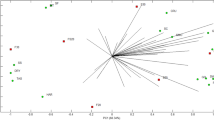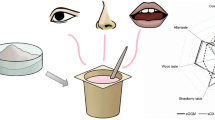Abstract
Galactomannans are polysaccharides commercially used in foods as gelling agents, thickeners, and stabilizers. In this study, a galactomannan partially hydrolyzed from Adenanthera pavonina seeds was used as stabilizer, fat substitute, and source of dietary fibers in a mousse milk dessert. First, characterizations of intact (GM) and partially hydrolyzed (GMPH) galactomannan from A. pavonina were made. Through Rotational Central Compound Design (RCCD) and the response surface methodology, we evaluated creaming index, lipid content, moisture content, and texture of the mousses. The formulation F7 (1.75% of GMPH and 4.92% of fat) was chosen among the developed formulations, and it was characterized by low moisture content (44.13%), low lipid content (6.67%), low firmness (2.10 N), and high percentage of dietary fiber (4.21%). This formulation was compared with a traditional formulation of lemon mousse (FT) and with another formulation with the same fat percentage as the chosen formulation without GMPH (F7L). The three formulation were characterized physicochemically and microbiologically, and sensorial acceptance tests were performed. The results indicated that no structural modifications were found in the galactomannan after its partial hydrolysis. and good sensory acceptance when compared to FT. The lemon mousses produced met sanitary specifications, remaining stable for 21 days of storage. We concluded that the use of GMPH from Adenanthera pavonina seeds in lemon mousses proved to be a stable, light dessert alternative and a potential source of dietary fiber.
Graphical abstract





Similar content being viewed by others
References
Soukoulis C, Gaiani C, Hooffmann L (2018) Plant seed mucilage as emerging biopolymerin food industry applications. Curr Opin Food Sci 22:28–42
Liu F, Changa W, Chena M, Xua F, Maa J, Zhong F (2020) Film-forming properties of guar gum, tara gum and locust bean gum. Food Hydrocolloids 98(105007):1–8
Bakhshy E, Zarinkamar F, Nazari M (2019) Isolation, qualitative and quantitative evaluation of galactomannan during germination of Trigonella persica (Fabacea) seed. Int J Biol Macromol 137:286–295
Prajapati VD, Jani GK, Moradiya NG, Randeria NP, Nagar BJ, Naikwadi NN, Variya BC (2013) Galactomannan: a versatile biodegradable seed polysaccharide. Int J Biol Macromol 60:83–92
Buriti FCA, Santos KMO, Sombra VG, Maciel JS, Teixeira Sá DMA, Salles HO, Oliveira G, Paula RCM, Feitosa JPA, Moreira ACOM, Moreira RA, Egito AS (2014) Characterisation of partially hydrolysed galactomannan from Caesalpinia pulcherrima seeds as a potential dietary fibre. Food Hidrocolloids 35:512–521
Hasan AMA, Abdel-Raouf ME (2018) Applications of guar gum, and its derivatives in petroleum industry: a review. Egypt J Petrol 27:1043–1050
Siqueira NM, Paiva B, Camassola M, Roshental-Kim EQ, Garcia KC, Santos F, Soares RMD (2015) Gelatin and galactomannan-based scaffolds: characterization and potential for tissue engineering applications. Carbohydr Polym 133:8–18
Albuquerque PBS, Barros W Jr, Santos GRC, Correia MTS, Mourão AS, Teixeira JA, Carneiro-Da-Cunha MG (2014) Characterization and rheological study of the galactomannan extracted from seeds of Cassia grandis. Carbohydr Polym 104:127–134
Salvalaggio MO, Freitas RA, Franqueto EM, Koop HS, Silveira JLM (2015) Influence of the extraction time on macromolecular parameters of galactomannans. Carbohydr Polym 116:200–206
George B, Suchithra TV (2019) Plant-derived bioadhesives for wound dressind and drug delivery system. Fitoterapia 137(104241):1–14
George A, Shah PA, Shrivastav PS (2019) Guar gum: versatile natural polymer for drug delivery applications. Eur Polymer J 112:722–735
Jiang J, Zhu WZ, Sun D, Jiang J (2012) Galactomannan (from Gleditsia sinensis Lam.) and xanthan gum matrix tablets for controlled delivery of theophylline: In vitro drug release and swelling behavior. Carbohydr Polym 87:2176–2182
Salarbashi D, Tafaghodi M (2018) An update on physicochemical and functional properties of newly seed gums. Int J Biol Macromol 119:1240–1247
Cerqueira MA, Pinheiro AC, Souza BWS, Lima AMP, Ribeiro C, Miranda C, Teixeira JA, Moreira RA, Coimbra MA, Gonçalves P, Vicente AA (2009) Extraction, purification and characterization of galactomannans from non-traditional sources. Carbohydr Polym 75:408–414
Passos AAC, Teixeira-Sá DMA, Morais GMD, Chacon LSS, Braga RC (2016) Avaliação da incorporação de galactomanana de Caesalpinia pulcherrima em sorvetes e comparação com estabilizantes comerciais. Revista Ciência Agronômica 47:364–372
Buriti FCA, Freitas SC, Egito AS, Santos KMO (2014) Effects of tropical fruit pulps and partially hydrolysed galactomannan from Caesalpinia pulcherrima seeds on the dietary fibre content, probiotic viability, texture and sensory features of goat dairy beverages. Food Sci Technol 59:196–203
Cerqueira MA, Souza BWS, Simões J, Teixeira JA, Domingues MRM, Coimbra MA, Vicente AA (2011) Structural and thermal characterization of galactomannans from non-conventional sources. Carbohydr Polym 83:179–185
Bento JF, Mazzaro I, Silva LMA, Moreira RA, Ferreira MLC, Petkowicz CLO (2013) Diverse patterns of cell wall mannan/galactomannan occurrence in seeds of the Leguminosae. Carbohydr Polym 92(2013):192–199
Lima AM, Cerqueira MA, Souza BWS, Santos ECM, Teixeira JA, Moreira RA et al (2010) New edible coatings composed of galactomannans and collagen blends to improve the postharvest quality of fruits e Influence on fruits gas transfer rate. J Food Eng 97:101–109
Silva FAK, Santos NL, Martins JRP, Chaves MJL, Braga RC (2018) Cookies made with galactomannans and xyloglucans from leguminosae seeds. Revista Brasileira de Agrotecnologia 8(1):1–7
Buriti FCA, Castro IA, Saad SMI (2010) Effects of refrigeration, freezing and replacement of milk fat by inulin and whey protein concentrate on texture profile and sensory acceptance of synbiotic guava mousses. Food Chem 123:1190–1197
Arancibia C, Castro C, Jublot CL, Costell E, Bayarri S (2015) Colour, rheology, flavour release and sensory perception of dairy desserts. Influence of thickener and fat content. Food Sci Technol 62:408–416
Balaghi S, Senge B (2014) Structural development of semi-solid dairy desserts influenced by hydrocolloids and temperature: rheology and particle size distribution. Int Dairy J 39:184–192
Jridi M, Souissi N, Salem MB, Ayadi MA, Nasri M, Azabou S (2015) Tunisian date (Phoenix dactylifera L.) by-products: characterization and potential effects on sensory, textural and antioxidant properties of dairy desserts. Food Chem 188:8–15
Matignon A, Michon C, Reichl P, Barey P, Mauduit S, Sieffermann JM (2016) Texture design based on chemical-physics knowledge of dairy neutral desserts: instrumental and sensory characterizations. Food Hydrocolloids 52:289–300
Braga RC, Teixeira-Sá DMA, Ribeiro AF, Miranda RL, Almeida LM, Horta AC, Moreira RA (2011) Evaluation of Caesalpinia Pulcherrima endospermic gum as affinity matrices for galactose-binding lectins interaction. Braz Arch Biol Technol 54:283–292
Rodrigues MI, Lemma AF (2009) Planejamento de experimentos e otimização de processos, 2ndª edn. Cárita, Campinas (Chapter 3)
AOAC. Official methods of analysis of the AOAC International. (2010). Official Method 991.43 Total, Soluble, and Insoluble Dietary Fibre in Foods. AOAC International, USA
Frange RCC, Garcia MTJ (2009) Desenvolvimento de emulsões óleo de oliva/água: avaliação da estabilidade física. Revista Ciência Farmacêutica Básica e Aplicada 30:263–271
Brasil. ANVISA. Resolução RDC nº 12, de 02 de janeiro de 2001. Regulamento técnico sobre padrões microbiológicos para alimentos. Brasília: Diário Oficial da União, Seção 1. <https://elegis.anvisa.gov.br/leisref/public/search.php>. Accessed 02 Setember 2014
Dutcosky, S. B. (2011). Análise sensorial de Alimentos. (3ª Ed.) Curitiba: Champagnat, (Chapther 4).
Cunha PLR, Castro RR, Rocha FAC, de Paula RCM, Feitosa JPA (2005) Low viscosity hydrogel of guar gum: preparation and physicochemical characterization. Int J Biol Macromol 37:99–104
Kapoor MP, Juneja LR (2009) Partially hydrolyzed guar gum dietary fibre. In: Cho SS, Samuel P (eds) Fibre ingredients: food applications and health benefits. CRC, Boca Raton, pp 79–120
Liyanage S, Abidi N, Auld D, Moussa H (2015) Chemical and physical characterization of galactomannan extracted from guar cultivars (Cyamopsis tetragonolobus L.). Ind Crops Prod 74:388–396
Cunha PLR, Vieira IGP, Arriaga AMC, de Paula RCM, Feitosa JPA (2009) Isolation and characterization of galactomannan from Dimorphandra gardneriana Tul. seeds as a potential guar gum substitute. Food Hydrocolloids 23:880–885
Jiang J, Jian H, Cristhian C, Zhanga W, Suna R (2011) Structural and thermal characterization of galactomannans from genus Gleditsia seeds as potential food gum substitutes. J Sci Food Agric 91:732–737
Hu C, Kong Q, Yang D, Pan Y (2011) Isolation and structural characterization of a novel galactomannan from Eremurus anisopterus (Ker. et Kir) Regel roots. Carbohyd Polym 4:402–406
Debon SJJ, Tester RF (2001) In vitro binding of calcium, iron and zinc by nonstarch polysaccharides. Food Chem 73:401–410
Godoi AM, Faccin-Galhardi LC, Lopes N, Nozawa C, Almeida RR, Ricardo NPS, Linhares REC (2015) Characterization and antiherpetic activity of native and chemically sulfated polysaccharide from Adenanthera pavonina. Curr Pharm Biotechnol 16:1024–1031
Mudgil D, Barak S, Khatkar BS (2012) X-ray diffraction, IR spectroscopy and thermal characterization of partially hydrolyzed guar gum. Int J Biol Macromol 50:1035–1039
Cardarelli HR, Aragon-Alegro LC, Alegro JHA, Castro IA, Saad SMI (2008) Effect of inulin and Lactobacillus paracasei on sensory and instrumental texture properties of functional chocolate mousse. J Sci Food Agric 88:1318–1324
Brasil. ANVISA. Resolução RDC n° 359, de 23 de dezembro de 2003. Regulamento técnico de Porções de Alimentos Embalados para Fins de Rotulagem Nutricional. Diário Oficial da União, Brasília, 26 de dezembro de 2003. Seção 1. <https://bvsms.saude.gov.br/bvs/saudelegis/anvisa/2003/res0359_23_12_2003.html>. Accessed 02 Setember. 2014.
Brasil. ANVISA. Lista de Alimentos com Alegações de Propriedades Funcionais e ou de Saúde. Alegações de propriedade funcional aprovadas. Atualizada em julho de 2008. < https://s.anvisa.gov.br/wps/s/r/wuE>. Accessed 14 July 2015.
Brasil. ANVISA. Resolução RDC n° 54, de 12 de novembro de 2012. Regulamento técnico sobre informação nutricional complementar. Brasília: Diário Oficial da União, 13 Nov. 2012, Seção 1. <bvsms.saude.gov.br/bvs/saudelegis/anvisa/2012/rdc0054_12_11_2012.html> Accessed 02 Setember 2014.
Brasil. ANVISA. Resolução RDC n° 3, de 4 de fevereiro de 2013. Modificações na composição de alimentos padronizados para uso de Informação Nutricional Complementar. Brasília: Diário Oficial da União, 5 Fev. 2013, Seção 1. < https://bvsms.saude.gov.br/bvs/saudelegis/anvisa/2013/rdc0003_04_02_2013.html>. Accessed 13 October 2015.
Acknowledgements
This study was financed by CNPq-SETEC/MEC, public notice number 17/2014. We would like to thank the Ceará Foundation for Scientific and Technological Development Support, FUNCAP; the Coordination for the Improvement of Higher Education Personnel, CAPES; the Brazilian Agricultural Research Corporation, Embrapa Goats and Sheep; and the Federal University of Ceará, UFC.
Funding
CNPq-SETEC/MEC, FUNCAP.
Author information
Authors and Affiliations
Corresponding author
Ethics declarations
Conflict of interest
The authors declare no conflicts of interest.
Additional information
Publisher's Note
Springer Nature remains neutral with regard to jurisdictional claims in published maps and institutional affiliations.
Electronic supplementary material
Below is the link to the electronic supplementary material.
Rights and permissions
About this article
Cite this article
Passos, A.A.C., Teixeira Sá, D.M.A., Andrade, P.L. et al. Partially hydrolyzed galactomannan from Adenanthera pavonina seeds used as stabilizer, fat substitute, and food fiber source for mousses. Polym. Bull. 78, 2951–2973 (2021). https://doi.org/10.1007/s00289-020-03246-9
Received:
Revised:
Accepted:
Published:
Issue Date:
DOI: https://doi.org/10.1007/s00289-020-03246-9




